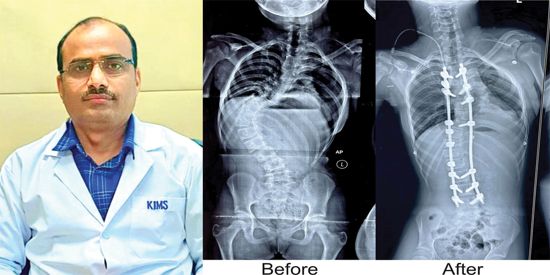KIMS doctors saves young girl’s life with Complex Spine Surgery

STATE TIMES NEWS
BHUBANESWAR: Kalinga Institute of Medical Sciences (KIMS), Bhubaneswar has successfully given a new lease of life to a teenage girl from Bhadrak, who was battling a spinal deformity known as Scoliosis.
The abnormal curve in her spine gave it an ‘S-shaped’ appearance, threatening her promising future.
However, thanks to the expertise of the doctors at KIMS, her spine was meticulously corrected in a recent complex operation, and she is now on the path to a full recovery, ready to embrace a normal life once again. This ground-breaking surgery marks the first time a private hospital in Odisha has performed such a complex procedure, reaffirming KIMS’s position as a leading provider of advanced healthcare in the state. The operation was skilfully carried out by Senior Consultant and Orthopaedic and Spine Surgeon, Dr. Jitendra Kumar Rout along with Anaesthsist Dr Sanjeev Giri and Dr Rajmohan.
Dr. Rout ensured that the young girl could return to her studies, play with her friends, and enjoy life without hindrance. were also took a major part in the surgery.
Dr. Rout explained that the spinal deformity the girl suffered from is known as “idiopathic scoliosis,” a condition that typically develops between the ages of 10 and 15 and if left untreated, can lead to severe deformities and significantly impact self-confidence and self-esteem.
Such patients often become targets of ridicule due to their appearance. Correcting the deformity at an early age is crucial, as it becomes more challenging to treat an advanced age.
The girl’s family visited several hospitals for treatment, including AIIMS, but had lost hope until they arrived at KIMS. After studying the case in detail, the medical team proceeded with the life-changing surgery, which was covered under the Biju Swasthya Kalyan Yojana (BSKY) scheme.
Notably, Dr. Rout, who is also the Secretary of the Spine Society of Odisha, accomplished the challenging operation in an impressive four hours, a procedure that typically takes 7-8 hours.
The success of the surgery was further aided by the use of an advanced ‘intraoperative neuro monitoring’ machine, which promptly alerts the doctors to any potential complications during the procedure.
